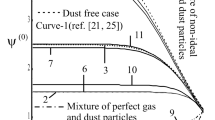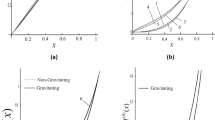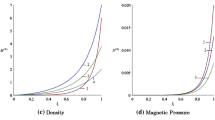Abstract
In this paper, the approximate analytical solution for the propagation of a blast (shock) wave in a rotating perfect gas in the case of cylindrical geometry is studied. The axial and azimuthal components of fluid velocity are taken into consideration, and these flow variables in the undisturbed medium are assumed to be varying according to the power laws with distance from the symmetry axis. The shock wave is considered to be strong one for the ratio \({\left(C/{W}_{S}\right)}^{2}\) to be a small quantity, where \(C\) is the sound velocity in undisturbed fluid and \({W}_{S}\) is the shock wave velocity. The initial density in the undisturbed medium is taken to be constant to obtain the similarity solution. To obtain the approximate analytical solution, the flow variables are expanded in power series in power of \({\left(C/{W}_{S}\right)}^{2}.\) The first- and second-order approximations to solutions are discussed with the help of power series expansion. The analytical solutions are constructed for the first-order approximation. The distribution of the flow variables for the first-order approximation in the flow-field region behind the blast wave is shown in graphs. A comparison is also made between the solutions obtained for non-rotating and rotating medium. It is shown that the constant quantity \({J}_{0}\) in the flow field region behind the shock front increases in rotating medium in comparison with its value in non-rotating medium; but an increase in adiabatic exponent causes a decrease in it. Further, it is concluded that shock strength increases with adiabatic exponent and decreases due to the consideration of the rotating medium.

reproduced from our earlier work Nath [40], with the permission from author and Elsevier via license no. 4862050594484 Date 4 July 2020)

Similar content being viewed by others
References
Sedov LI (1946) Propagation of strong shock waves. J Appl Math Mech 10:241–250
Taylor G (1950) The formation of a blast wave by a very intense explosion. I. Theoretical discussion. Proc R Soc Lond Ser A 201:159–174
Allen GE, Chow K, DeLaney T, Filipovic MD, Houck JC, Pannuti TG, Stage MD (2015) On the expansion rate, age, and distance of the supernova remnant G266.2-1.2 (Vela Jr.). Astrophys J 798(82):1–12
Leahy DA, Ranasinghe S (2016) Distance and evolutionary state of the supernova remnant 3C 397 (G41.1-0.3). Astrophys J 817(74):1–9
Lerche I, Vasyliunas VM (1976) Mathematical theory of isothermal blast waves and the question of their applicability to supernova remnants. Astrophys J 210:85–99
Solinger A, Buff J, Rappaport S (1975) Isothermal blast wave model of supernova remnants. Astrophys J 201:381–386
Vink J (2012) Supernova remnants: the X-ray perspective. Astron Astrophys Rev 20(49):1–120
Woltjer L (1972) Supernova remnants. Ann. Rev. Astron Astrophys 10:129–158
Yan ZY, Zhang HQ (2001) Symbolic computation and new families of exact soliton-like solutions to the integrable Broer–Kaup (BK) equations in (2+1)-dimensional spaces. J Phys A Math Gen 34:1785–1792
Daghan D, Donmez O (2016) Exact solutions of the Gardner equation and their applications to the different physical plasmas. Braz J Phys 46:321–333
Nath G, Dutta M, Pathak RP (2020) Exact similarity solution for the propagation of spherical shock wave in a van der Waals gas with azimuthal magnetic field, radiation heat flux, radiation pressure and radiation energy under gravitational field. Proc Natl Acad Sci India 90A:789–801
Sedov LI (1982) Similarity and dimensional methods in mechanics. Mir Publishers, Mascow
Zel’dovich YB, Raizer YP (1967) Physics of shock waves and high temperature hydrodynamic phenomena, vol II. Academic Press, New York
Lu JF, Yuan F (1998) Global solution of adiabatic accretion flows with isothermal shocks in Kerr black hole geometry. Mon Not R Astron Soc 295:66–74
Fukumura K, Tsuruta S (2004) Isothermalshock formation in nonequatorial acceretion flows around black holes. APJ 611:964–976
Chaturani P (1970) Strong cylindrical shocks in a rotating gas. Appl Sci Res 23:197–211
Sakurai A (1956) Propagation of spherical shock waves in stars. J Fluid Mech 1:436–453
Levin VA, Skopina GA (2004) Detonation wave propagation in rotational gas flows. J Appl Mech Tech Phys 45:457–460
Vishwakarma JP, Maurya AK, Singh KK (2007) Self-similar adiabatic flow headed by a magnetogasdynamic cylindrical shock wave in a rotating non-ideal gas. Geophys Astrophys Fluid Dyna 101:155–168
Nath G (2010) Propagation of a cylindrical shock wave in a rotational axisymetric dusty gas with exponentially varying density. Res Astron Astrophys 10:445–460
Viswhwakarma JP, Nath G (2010) Propagation of a cylindrical shock wave in a rotating dusty gas with heat-conduction and radiation heat flux. Phys Scr 81:045401
Nath G (2011) Magnetogasdynamic shock wave generated by a moving piston in a rotational axisymmetric isothermal flow of perfect gas with variable density. Adv Space Res 47:1463–1471
Nath G (2012) Self-similar solution of cylindrical shock wave propagation in a rotational axisymmetric mixture of a non-ideal gas and small solid particles. Meccanica 47:1797–1814
Viswhwakarma JP, Nath G (2012) Similarity solution for a cylindrical shock wave in a rotational axisymmetric dusty gas with heat conduction and radiation heat flux. Commun Nonlinear Sci Numer Simulat 17:154–169
Nath G (2014) Self-similar solution for unsteady flow behind an exponential shock in an axisymmetric rotating dusty gas. Shock Waves 24:415–428
Nath G (2015) Similarity solutions for unsteady flow behind an exponential shock in an axisymmetric rotating non-ideal gas. Meccanica 50:1701–1715
Nath G (2015) Cylindrical shock wave in a rotational axisymmetric non-ideal dusty gas with increasing energy in the presence of conductive and radiative heat fluxes. Ain Shams Eng J 6:1053–1068
Nath G (2019) Cylindrical shock wave generated by a moving piston in a rotational axisymmetric non-ideal gas with conductive and radiative heat-fluxes in the presence of azimuthal magnetic field. Acta Astronat 156:100–112
Taylor GI (1950) The formation of a blast wave by a very intense explosion-II. The atomic explosion of 1945. Proc R Soc Lond 201A:175–186
Sakurai A (1953) On the propagation and structure of the blast wave I. J Phys Soc Jpn 8:662–669
Sakurai A (1954) On the propagation and structure of a blast wave II. J Phys Soc Jpn 9:256–266
Shao-Chi L (1954) Cylindrical shock waves produced by instantaneous energy release. J Appl Phys 25:54–57
Arad B, Gazit Y, Ludmirsk A (1987) A sliding discharge device for producing cylindrical shock waves. J Phys D: Appl Phys 20:360–367
Dryer M (1974) Interplanetary shock waves generated by solar flares. Space Sci Rev 15:403–468
Nath G, Vishwakarma JP (2016) Propagation of a strong spherical shock wave in a gravitating or non-gravitating dusty gas with exponentially varying density. Acta Astronat 123:200–213
Rybakin B, Smirnov N, Goryachev V (2017) Parallel algorithm for simulation of fragmentation and formation of filamentous structures in molecular clouds. Commun Comput Inf Sci 687:146–157
Elmegreen BG (1979) Gravitational collapse in dust lanes and the appearance of spiral structure in galaxies. Astrophys J 231:372–383
Rybakin BP, Betelin VB, Dushin VR, Mikhalchenko EV, Moiseenko SG, Stamov LI, Tyurenkova VV (2016) Model of turbulent destruction of molecular clouds. Acta Astronaut 119:131–136
Rybakin BP, Betelin VB, Smirnov NN, Moiseenko SG, Stamov LI (2018) 3D numerical simulation of molecular clouds collision process. IOP Conf Ser J Phys Conf Ser 1103:012007
Nath G (2019) Propagation of strong cylindrical shock wave in a self-gravitating rotational axisymmetric mixture of small solid particles and perfect gas with density varying exponentially. Acta Astronat 162:447–460
Hutchens GJ (1995) Approximate cylindrical blast theory: nearfield solutions. J Appl Phys 77:2912–2915
Author information
Authors and Affiliations
Corresponding author
Additional information
Publisher's Note
Springer Nature remains neutral with regard to jurisdictional claims in published maps and institutional affiliations.
Rights and permissions
About this article
Cite this article
Nath, G., Kaur, A. & Chaurasia, S. On the Blast Wave Propagation and Structure in a Rotational Axisymmetric Perfect Gas. Proc. Natl. Acad. Sci., India, Sect. A Phys. Sci. 92, 167–178 (2022). https://doi.org/10.1007/s40010-021-00737-w
Received:
Revised:
Accepted:
Published:
Issue Date:
DOI: https://doi.org/10.1007/s40010-021-00737-w




